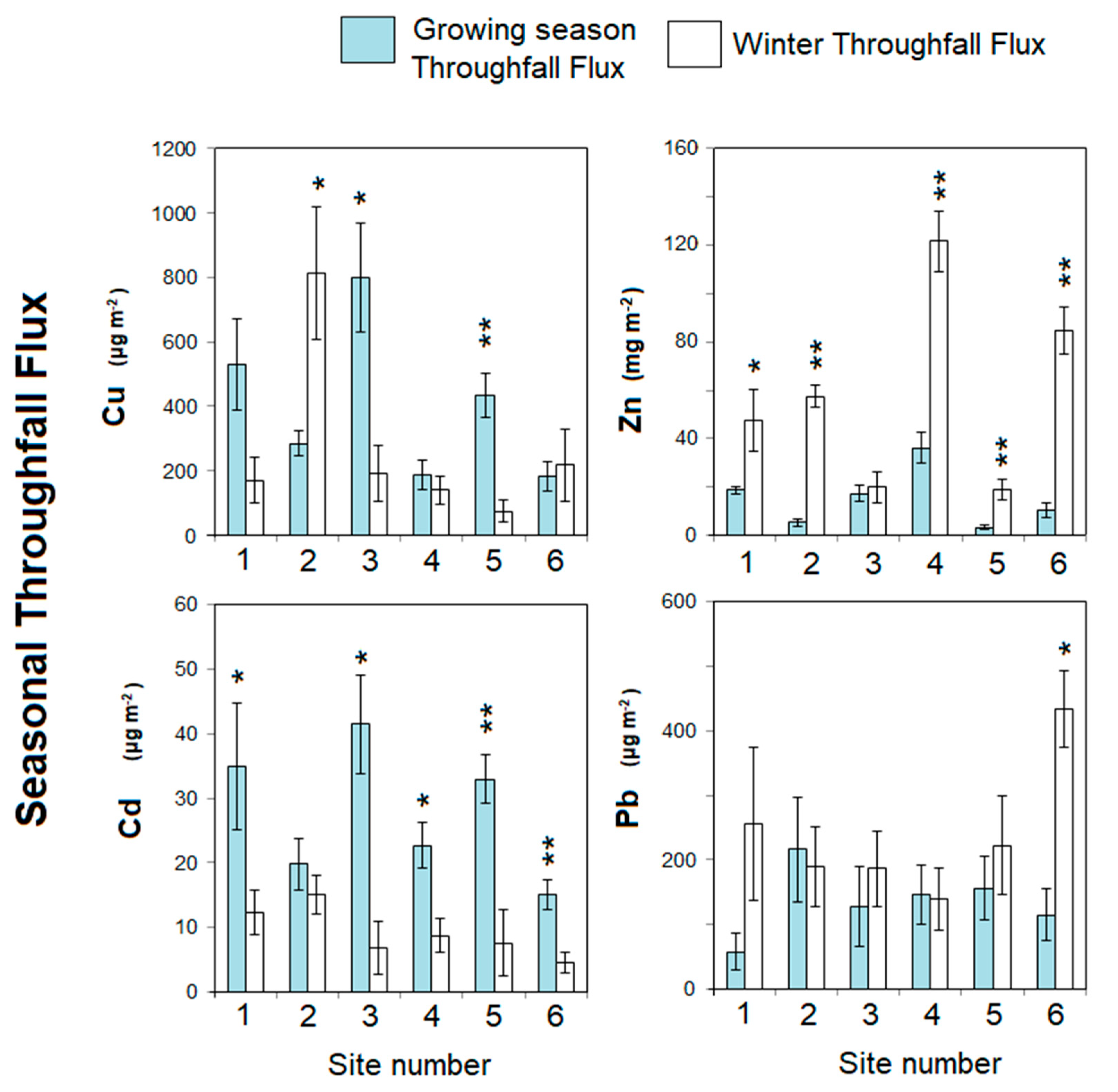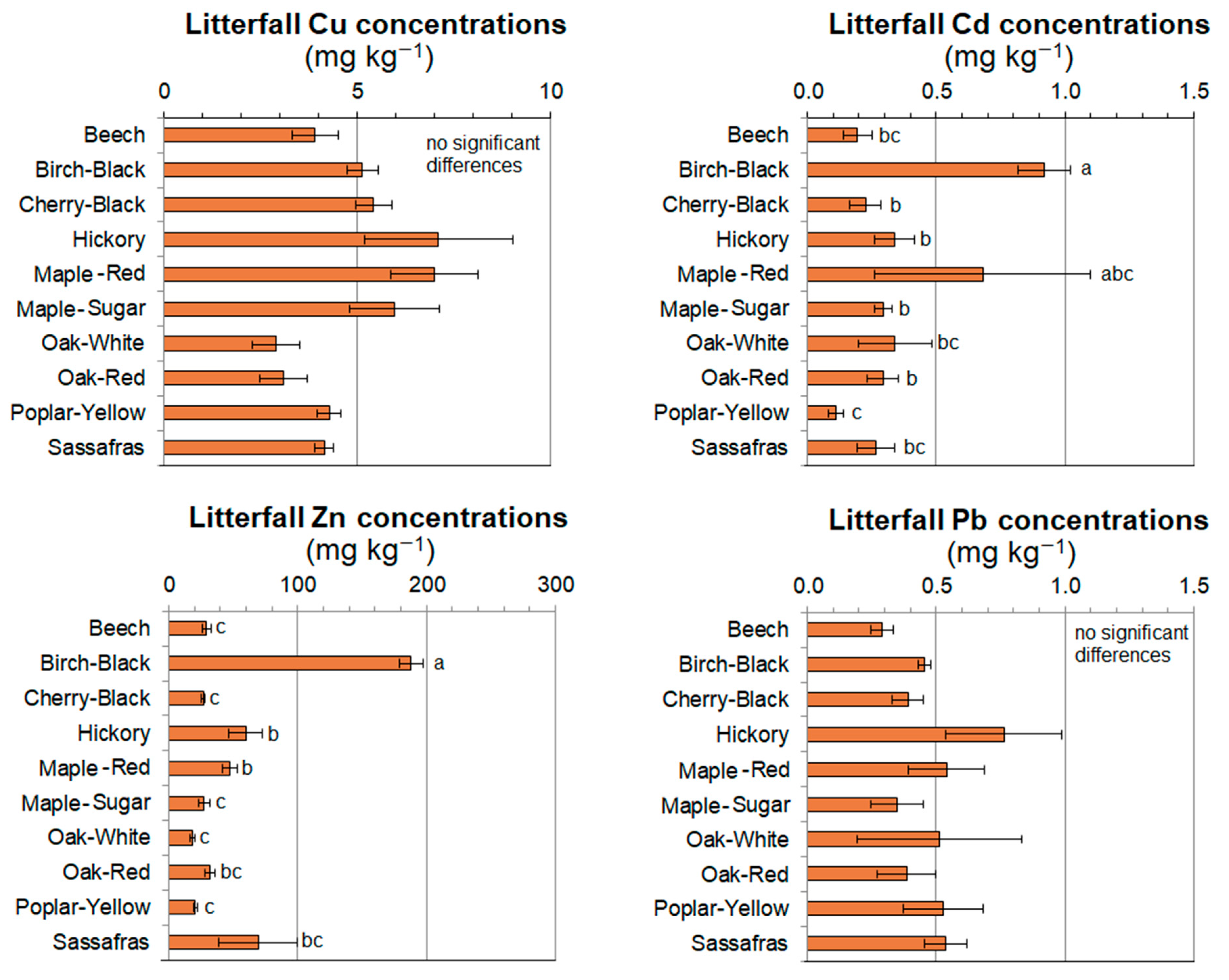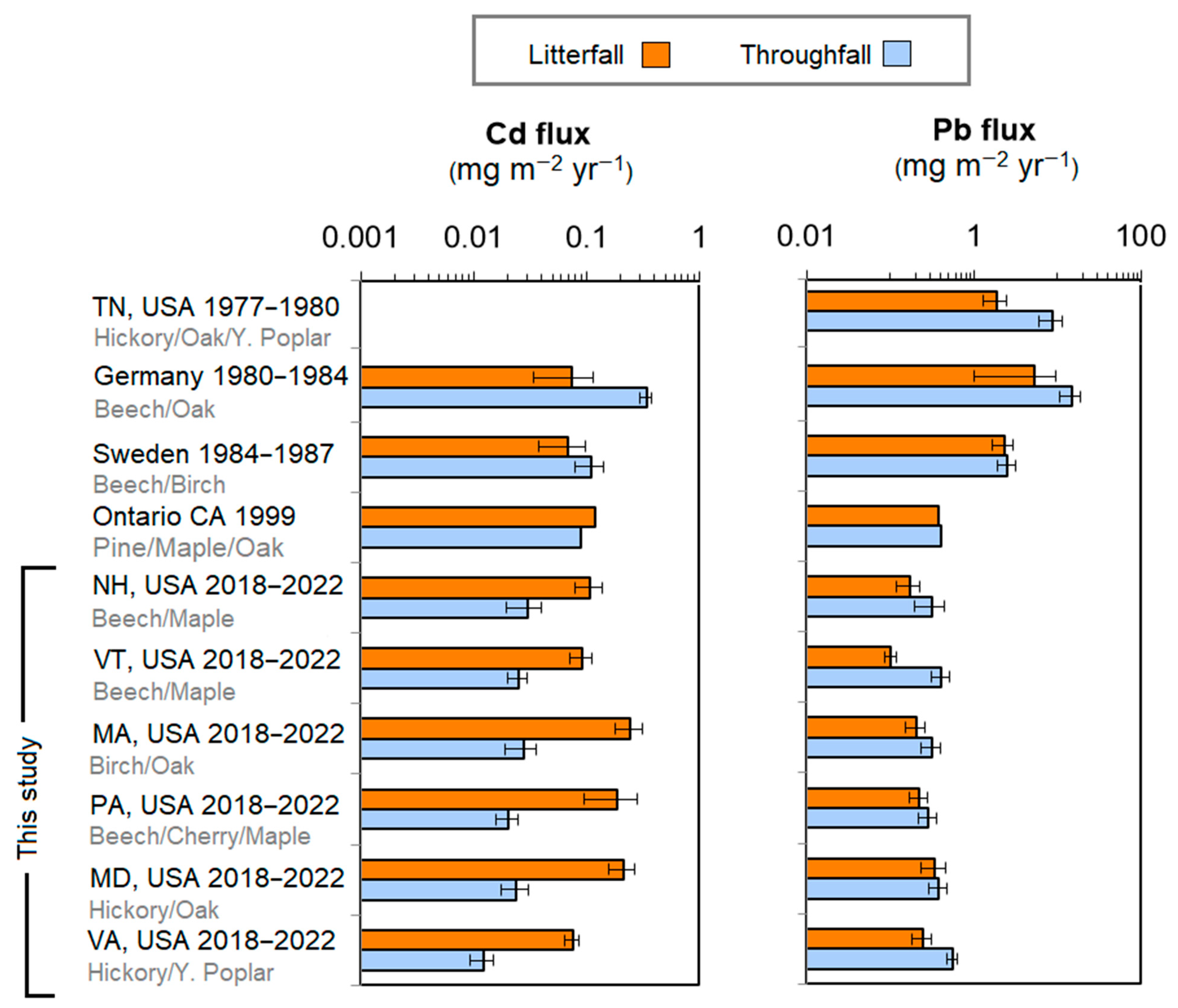Throughfall and Litterfall Fluxes Reveal New Inputs and Foliar Cycling Maintain Pb, Cd, Cu, and Zn Pollution Legacy in Eastern U.S. Temperate Forests
Abstract
1. Introduction
2. Materials and Methods
2.1. Field Study Sites
2.2. Throughfall Collection and Flux Measurements
2.3. Aboveground Litterfall Fluxes
2.4. Data Analyses
3. Results and Discussion
3.1. Throughfall Concentrations
3.2. Throughfall Fluxes
3.3. Litterfall Concentrations
| Site/Study | Trees | Location | Years | Cu | Zn | Cd | Pb |
|---|---|---|---|---|---|---|---|
| mg kg−1 | mg kg−1 | mg kg−1 | mg kg−1 | ||||
| (This study) Site 1 | Beech/Maple | NH, USA | 2018–2022 | 3.2 ± 0.6 | 21.1 ± 4.6 | 0.14 ± 0.04 | 0.22 ± 0.06 |
| (This study) Site 2 | Beech/Maple | VT, USA | 2018–2022 | 1.7 ± 0.3 | 14.7 ± 2.9 | 0.12 ± 0.03 | 0.14 ± 0.02 |
| (This study) Site 3 | Birch/Oak | MA, USA | 2018–2022 | 2.8 ± 0.3 | 47.4 ± 6.4 | 0.36 ± 0.08 | 0.38 ± 0.08 |
| (This study) Site 4 | Beech/Cherry/Maple | PA, USA | 2018–2022 | 3.8 ± 0.8 | 21.5 ± 5.5 | 0.23 ± 0.11 | 0.27 ± 0.06 |
| (This study) Site 5 | Hickory/Oak | MD, USA | 2018–2022 | 2.1 ± 0.2 | 21.5 ± 3.8 | 0.28 ± 0.06 | 0.52 ± 0.15 |
| (This study) Site 6 | Hickory/Yellow Poplar | VA, USA | 2018–2022 | 4.9 ± 1.1 | 21.3 ± 4.8 | 0.10 ± 0.03 | 0.30 ± 0.06 |
| Pan and Wang [35] | Mixed Chinese | Eastern China | 2013 | 8.2 | 39 | - | 4.9 |
| Richardson and Friedland [38] | Beech/Birch/Maple | VT, NH USA | 2012–2014 | 7.1 | 73.7 | 0.48 | 0.39 |
| McGee et al. [40] | Birch/Aspen/Maple | ME, USA | 2004 | - | 274 | 1.16 | 0.47 |
| Landre et al. [34] | Pine/Maple/Oak | Ontario, CA | 1999 | 3.4 | 54.2 | 0.21 | 0.20 |
| Laskowski | Oak/Hornbeam | Poland | 1988 | 12.9 | 93.5 | 0.64 | 13.1 |
| Nordén [41] | Beech/Oak/Hornbeam | S. Sweden | 1986–1988 | 5.9 | 36.2 | - | 3.9 |
| Smith and Siccama [42] | Beech/Birch/Maple | NH, USA | 1975 | - | - | - | 6.1 |
| Bergkvist et al. (1988) [16] | Beech | Central Germany | 1974 | 24 | 69 | 0.70 | 33 |
| Gosz et al. [43] | Beech/Birch/Maple | NH, USA | 1973 | 7.7 | 192 | - | - |
3.4. Litterfall Fluxes
3.5. Comparing Throughfall and Litterfall Fluxes, Past and Present
4. Conclusions
Author Contributions
Funding
Data Availability Statement
Acknowledgments
Conflicts of Interest
References
- Kuklinska, K.; Wolska, L.; Namiesnik, J. Air quality policy in the US and the EU—A review. Atmos. Pollut. Res. 2015, 6, 129–137. [Google Scholar] [CrossRef]
- Schmalensee, R.; Stavins, R.N. Policy Evolution under the Clean Air Act. J. Econ. Perspect. 2019, 33, 27–50. [Google Scholar] [CrossRef]
- Johnson, C.E.; Siccama, T.G.; Driscoll, C.T.; Likens, G.E.; Moeller, R.E. Changes in lead biogeochemistry in response to decreasing atmospheric inputs. Ecol. Appl. 1995, 5, 813–822. [Google Scholar] [CrossRef]
- Buckley, S.M.; Mitchell, M.J. Improvements in urban air quality: Case studies from New York State, USA. Water Air Soil Pollut. 2011, 214, 93–106. [Google Scholar] [CrossRef]
- Richardson, J.B.; Donaldson, E.C.; Kaste, J.M.; Friedland, A.J. Forest floor lead, copper and zinc concentrations across the northeastern United States: Synthesizing spatial and temporal responses. Sci. Total Environ. 2015, 505, 851–859. [Google Scholar] [CrossRef] [PubMed]
- Kabata-Pendias, A.; Mukherjee, A.B. Humans; Springer: Berlin/Heidelberg, Germany, 2007; pp. 67–83. [Google Scholar]
- Srivastava, V.; Sarkar, A.; Singh, S.; Singh, P.; De Araujo, A.S.; Singh, R.P. Agroecological responses of heavy metal pollution with special emphasis on soil health and plant performances. Front. Environ. Sci. 2017, 5, 64. [Google Scholar] [CrossRef]
- Banerjee, B.P.; Raval, S.; Zhai, H.; Cullen, P.J. Health condition assessment for vegetation exposed to heavy metal pollution through airborne hyperspectral data. Environ. Monit. Assess. 2017, 189, 1–11. [Google Scholar] [CrossRef]
- Lynes, M.A.; Kang, Y.J.; Sensi, S.L.; Perdrizet, G.A.; Hightower, L.E. Heavy metal ions in normal physiology, toxic stress, and cytoprotection. Ann. N. Y. Acad. Sci. 2007, 1113, 159–172. [Google Scholar] [CrossRef]
- Genchi, G.; Sinicropi, M.S.; Lauria, G.; Carocci, A.; Catalano, A. The effects of cadmium toxicity. Int. J. Environ. Res. Public Health 2020, 17, 3782. [Google Scholar] [CrossRef]
- Flora, G.; Gupta, D.; Tiwari, A. Toxicity of lead: A review with recent updates. Interdiscip. Toxicol. 2012, 5, 47–58. [Google Scholar] [CrossRef]
- Kraepiel, A.M.L.; Dere, A.L.; Herndon, E.M.; Brantley, S.L. Natural and anthropogenic processes contributing to metal enrichment in surface soils of central Pennsylvania. Biogeochemistry 2015, 123, 265–283. [Google Scholar] [CrossRef]
- Merchant, S.S. The elements of plant micronutrients. Plant Physiol. 2010, 154, 512–515. [Google Scholar] [CrossRef] [PubMed]
- Rehman, M.; Liu, L.; Wang, Q.; Saleem, M.H.; Bashir, S.; Ullah, S.; Peng, D. Copper environmental toxicology, recent advances, and future outlook: A review. Environ. Sci. Pollut. Res. 2019, 26, 18003–18016. [Google Scholar] [CrossRef] [PubMed]
- Noulas, C.; Tziouvalekas, M.; Karyotis, T. Zinc in soils, water and food crops. J. Trace Elem. Med. Biol. 2018, 49, 252–260. [Google Scholar] [CrossRef]
- Bergkvist, B.; Folkeson, L.; Berggren, D. Fluxes of Cu, Zn, Pb, Cd, Cr, and Ni in temperate forest ecosystems: A literature review. Water Air Soil Pollut. 1989, 47, 217–286. [Google Scholar] [CrossRef]
- Duan, Q.; Lee, J.; Liu, Y.; Chen, H.; Hu, H. Distribution of heavy metal pollution in surface soil samples in China: A graphical review. Bull. Environ. Contam. Toxicol. 2016, 97, 303–309. [Google Scholar] [CrossRef]
- Beavington, F.; Cawse, P.A.; Wakenshaw, A. Comparative studies of atmospheric trace elements: Improvements in air quality near a copper smelter. Sci. Total Environ. 2004, 332, 39–49. [Google Scholar] [CrossRef]
- Newhook, R.; Hirtle, H.; Byrne, K.; Meek, M.E. Releases from copper smelters and refineries and zinc plants in Canada: Human health exposure and risk characterization. Sci. Total Environ. 2003, 301, 23–41. [Google Scholar] [CrossRef]
- Camarero, L.; Bacardit, M.; de Diego, A.; Arana, G. Decadal trends in atmospheric deposition in a high elevation station: Effects of climate and pollution on the long-range flux of metals and trace elements over SW Europe. Atmos. Environ. 2017, 167, 542–552. [Google Scholar] [CrossRef]
- US Environmental Protection Agency. Aquatic Life Ambient Freshwater Quality Criteria—Copper; USEPA: Washington, DC, USA, 2007; EPA-822-R-07-001.
- Kumar, V.; Pandita, S.; Sidhu, G.P.S.; Sharma, A.; Khanna, K.; Kaur, P.; Bali, A.S.; Setia, R. Copper bioavailability, uptake, toxicity and tolerance in plants: A comprehensive review. Chemosphere 2021, 262, 127810. [Google Scholar] [CrossRef]
- Lukkari, T.; Aatsinki, M.; Väisänen, A.; Haimi, J. Toxicity of copper and zinc assessed with three different earthworm tests. Appl. Soil Ecol. 2005, 30, 133–146. [Google Scholar] [CrossRef]
- Malhotra, N.; Ger, T.R.; Uapipatanakul, B.; Huang, J.C.; Chen, K.H.C.; Hsiao, C.D. Review of copper and copper nanoparticle toxicity in fish. Nanomaterials 2020, 10, 1126. [Google Scholar] [CrossRef] [PubMed]
- Roman, Y.E.; De Schamphelaere, K.A.; Nguyen, L.T.; Janssen, C.R. Chronic toxicity of copper to five benthic invertebrates in laboratory-formulated sediment: Sensitivity comparison and preliminary risk assessment. Sci. Total Environ. 2007, 387, 128–140. [Google Scholar] [CrossRef] [PubMed]
- Galloway, J.N.; Likens, G.E.; Keene, W.C.; Miller, J.M. The composition of precipitation in remote areas of the world. J. Geophys. Res. Ocean. 1982, 87, 8771–8786. [Google Scholar] [CrossRef]
- Cheng, I.; Al Mamun, A.; Zhang, L. A synthesis review on atmospheric wet deposition of particulate elements: Scavenging ratios, solubility, and flux measurements. Environ. Rev. 2021, 29, 340–353. [Google Scholar] [CrossRef]
- Zang, F.; Zhao, C. Atmospheric deposition inputs more trace elements than litterfall in primitive forest soils. Catena 2024, 244, 108262. [Google Scholar] [CrossRef]
- Richardson, J.; Dobson, A. Litterfall and Throughfall Data for Six Sites along Appalachian Mountain Range, Eastern United States; University of Virginia Dataverse: University of Virginia: Charlottesville, VA, USA, 2024. [Google Scholar] [CrossRef]
- Gandois, L.; Nicolas, M.; Vanderheijden, G.; Probst, A. The importance of biomass net uptake for a trace metal budget in a forest stand in north-eastern France. Sci. Total Environ. 2010, 408, 5870–5877. [Google Scholar] [CrossRef][Green Version]
- Zhang, S.; Yu, J.; Pan, T.; Gao, X.; Qiu, Z.; Hou, L. Difference between rainfall and throughfall chemistry for different forest stands in the Qinling Mountains, China. Hydrol. Res. 2021, 52, 523–535. [Google Scholar] [CrossRef]
- Sweet, C.W.; Weiss, A.; Vermette, S.J. Atmospheric deposition of trace metals at three sites near the Great Lakes. Water Air Soil Pollut. 1998, 103, 423–439. [Google Scholar] [CrossRef]
- Voldrichova, P.; Chrastny, V.; Sipkova, A.; Farkas, J.; Novak, M.; Stepanova, M.; Krachler, M.; Veselovsky, F.; Blaha, V.; Prechova, E.; et al. Zinc isotope systematics in snow and ice accretions in Central European mountains. Chem. Geol. 2014, 388, 130–141. [Google Scholar] [CrossRef]
- Landre, A.L.; Watmough, S.A.; Dillon, P.J. Metal pools, fluxes, and budgets in an acidified forested catchment on the Precambrian Shield, Central Ontario, Canada. Water Air Soil Pollut. 2010, 209, 209–228. [Google Scholar] [CrossRef]
- Pan, Y.P.; Wang, Y.S. Atmospheric wet and dry deposition of trace elements at ten sites in Northern China. Atmos Chem. Phys. 2014, 14, 20647–20676. [Google Scholar]
- Thapalia, A.; Borrok, D.M.; Van Metre, P.C.; Wilson, J. Zinc isotopic signatures in eight lake sediment cores from across the United States. Environ. Sci. Technol. 2015, 49, 132–140. [Google Scholar] [CrossRef] [PubMed]
- Rea, A.W.; Lindberg, S.E.; Keeler, G.J. Dry deposition and foliar leaching of mercury and selected trace elements in deciduous forest throughfall. Atmos. Environ. 2001, 35, 3453–3462. [Google Scholar] [CrossRef]
- Richardson, J.B.; Friedland, A.J. Influence of coniferous and deciduous vegetation on major and trace metals in forests of northern New England, USA. Plant Soil 2016, 402, 363–378. [Google Scholar] [CrossRef]
- Avila, A.; Rodrigo, A. Trace metal fluxes in bulk deposition, throughfall and stemflow at two evergreen oak stands in NE Spain subject to different exposure to the industrial environment. Atmos. Environ. 2004, 38, 171–180. [Google Scholar] [CrossRef]
- McGee, C.J.; Fernandez, I.J.; Norton, S.A.; Stubbs, C.S. Cd, Ni, Pb, and Zn concentrations in forest vegetation and soils in Maine. Water Air Soil Pollut. 2007, 180, 141–153. [Google Scholar] [CrossRef]
- Nordén, U. Leaf litterfall concentrations and fluxes of elements in deciduous tree species. Scand. J. For. Res. 1994, 9, 9–16. [Google Scholar] [CrossRef]
- Smith, W.H.; Siccama, T.G. The Hubbard Brook Ecosystem Study: Biogeochemistry of Lead in the Northern Hardwood Forest; American Society of Agronomy, Crop Science Society of America, and Soil Science Society of America: Madison, WI, USA, 1981; Volume 10, pp. 323–333. [Google Scholar]
- Gosz, J.R.; Likens, G.E.; Bormann, F.H. Nutrient release from decomposing leaf and branch litter in the Hubbard Brook Forest, New Hampshire. Ecol. Monogr. 1973, 43, 173–191. [Google Scholar] [CrossRef]
- Schebek, L.; Lieser, K.H.; Höllwarth, M. Birch (Betula pendula) as a bioindicator for heavy metal pollution. Angew. Bot. 1984, 58, 475–482. [Google Scholar]
- Denny, H.J.; Wilkins, D.A. Zinc tolerance in Betula spp. I. Effect of external concentration of zinc on growth and uptake. New Phytol. 1987, 106, 517–524. [Google Scholar] [CrossRef]
- Jonczak, J.; Jankiewicz, U.; Kondras, M.; Kruczkowska, B.; Oktaba, L.; Oktaba, J.; Olejniczak, I.; Pawłowicz, E.; Polláková, N.; Raab, T.; et al. The influence of birch trees (Betula spp.) on soil environment—A review. For. Ecol. Manag. 2020, 477, 118486. [Google Scholar] [CrossRef]
- NOAA. National Centers for Environmental Information, Monthly National Climate Report for Annual 2022. Available online: https://www.ncei.noaa.gov/access/monitoring/monthly-report/national/202213 (accessed on 18 July 2024).
- Van Hook, R.; Harris, W.F.; Henderson, G.S. Cadmium, lead, and zinc distributions and cycling in a mixed deciduous forest. Ambio 1977, 6, 281–286. [Google Scholar]
- Van Hook, R.I.; Nielsen, M.G.; Shugart, H.H. Energy and Nitrogen Relation for a Macrosiphum Liriodendri (Homoptera: Aphididae) Population in an East Tennessee Liriodendron Tulipifera Stand. Ecology 1980, 61, 960–975. [Google Scholar] [CrossRef]
- Schultz, R. Vergleichende Betrachtung des Schwermetallhaushalts verschiedener Watdökosysteme Norddeutschlands. In Ber. d. Forschungszentr. Waldökosysteme/Waldsterben, Reihe A, Bd 32; Universität Göttingen: Göttingen, Germany, 1987; p. 217. [Google Scholar]
- Butler, M.J.; Yellen, B.C.; Oyewumi, O.; Ouimet, W.; Richardson, J.B. Accumulation and transport of nutrient and pollutant elements in riparian soils, sediments, and river waters across the Thames River Watershed, Connecticut, USA. Sci. Total Environ. 2023, 899, 165630. [Google Scholar] [CrossRef]
- Shahid, M.; Natasha; Dumat, C.; Niazi, N.K.; Xiong, T.T.; Farooq, A.B.U.; Khalid, S. Ecotoxicology of heavy metal (loid)-enriched particulate matter: Foliar accumulation by plants and health impacts. Rev. Environ. Contam. Toxicol. Vol. 2021, 253, 65–113. [Google Scholar]
- Wang, H.; Xing, Y.; Yang, J.; Xie, B.; Shi, H.; Wang, Y. The nature and size fractions of particulate matter deposited on leaves of four tree species in Beijing, China. Forests 2022, 13, 316. [Google Scholar] [CrossRef]







| Site Name | Site Number | Elevation | 30 yr MAT 1 | 30 yr MAP 1 | Forest Type |
|---|---|---|---|---|---|
| m a.s.l. | °C | mm | |||
| Mt. Moosilauke, NH | Site 1 | 570 | 6 | 1180 | Beech/Maple |
| Mt. Ascutney State forest, VT | Site 2 | 380 | 6 | 965 | Beech/Maple |
| MacLeish Field Station, MA | Site 3 | 270 | 9 | 1205 | Birch/Oak |
| Tobyhanna State Forest, PA | Site 4 | 610 | 8 | 1080 | Beech/Cherry/Maple |
| Green Ridge State Forest, MD | Site 5 | 420 | 11 | 1066 | Hickory/Oak |
| Lesesne State Forest, VA | Site 6 | 380 | 14 | 1092 | Hickory/Yellow Poplar |
| Site | Season | Years | Cu | Zn | Cd | Pb |
|---|---|---|---|---|---|---|
| ng L−1 | µg L−1 | ng L−1 | ng L−1 | |||
| Site 1 | Growing season | 2018–2022 | 700 ± 199 | 37 ± 8 | 51 ± 18 | 30 ± 13 |
| Site 2 | Growing season | 2018–2022 | 213 ± 50 | 11 ± 1 | 21 ± 6 | 45 ± 9 |
| Site 3 | Growing season | 2018–2022 | 761 ± 220 | 31 ± 5 | 38 ± 8 | 31 ± 7 |
| Site 4 | Growing season | 2018–2022 | 458 ± 71 | 157 ± 51 | 35 ± 5 | 56 ± 8 |
| Site 5 | Growing season | 2018–2022 | 461 ± 103 | 6 ± 1 | 29 ± 4 | 30 ± 5 |
| Site 6 | Growing season | 2018–2022 | 219 ± 27 | 18 ± 7 | 15 ± 1 | 22 ± 1 |
| Site 1 | Winter | 2018–2022 | 264 ± 80 | 48 ± 6 | 18 ± 3 | 39 ± 10 |
| Site 2 | Winter | 2018–2022 | 1271 ± 324 | 54 ± 6 | 23 ± 4 | 30 ± 5 |
| Site 3 | Winter | 2018–2022 | 338 ± 74 | 11 ± 5 | 10 ± 3 | 32 ± 5 |
| Site 4 | Winter | 2018–2022 | 426 ± 120 | 165 ± 63 | 18 ± 1 | 39 ± 9 |
| Site 5 | Winter | 2018–2022 | 191 ± 27 | 19 ± 7 | 21 ± 4 | 50 ± 10 |
| Site 6 | Winter | 2018–2022 | 342 ± 92 | 87 ± 21 | 8 ± 1 | 70 ± 2 |
Disclaimer/Publisher’s Note: The statements, opinions and data contained in all publications are solely those of the individual author(s) and contributor(s) and not of MDPI and/or the editor(s). MDPI and/or the editor(s) disclaim responsibility for any injury to people or property resulting from any ideas, methods, instructions or products referred to in the content. |
© 2024 by the authors. Licensee MDPI, Basel, Switzerland. This article is an open access article distributed under the terms and conditions of the Creative Commons Attribution (CC BY) license (https://creativecommons.org/licenses/by/4.0/).
Share and Cite
Richardson, J.B.; Truong, M.T.; Dobson, A.M. Throughfall and Litterfall Fluxes Reveal New Inputs and Foliar Cycling Maintain Pb, Cd, Cu, and Zn Pollution Legacy in Eastern U.S. Temperate Forests. Pollutants 2024, 4, 474-489. https://doi.org/10.3390/pollutants4040032
Richardson JB, Truong MT, Dobson AM. Throughfall and Litterfall Fluxes Reveal New Inputs and Foliar Cycling Maintain Pb, Cd, Cu, and Zn Pollution Legacy in Eastern U.S. Temperate Forests. Pollutants. 2024; 4(4):474-489. https://doi.org/10.3390/pollutants4040032
Chicago/Turabian StyleRichardson, Justin B., Minh Tri Truong, and Annise M. Dobson. 2024. "Throughfall and Litterfall Fluxes Reveal New Inputs and Foliar Cycling Maintain Pb, Cd, Cu, and Zn Pollution Legacy in Eastern U.S. Temperate Forests" Pollutants 4, no. 4: 474-489. https://doi.org/10.3390/pollutants4040032
APA StyleRichardson, J. B., Truong, M. T., & Dobson, A. M. (2024). Throughfall and Litterfall Fluxes Reveal New Inputs and Foliar Cycling Maintain Pb, Cd, Cu, and Zn Pollution Legacy in Eastern U.S. Temperate Forests. Pollutants, 4(4), 474-489. https://doi.org/10.3390/pollutants4040032






